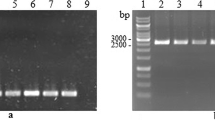Abstract
Various conditions for zygote formation and germination inClosterium ehrenbergii were studied. HEPES buffered conjugation medium not only increased zygote formation, but also hastened germination. Zygote formation and germination depended largely on the state of cells before mating. Pre-culturing for 10 days was found optimal for zygote formation, while a 5 day or 10 to 20 day pre-culture was best suited for zygote germination. Interestingly, pre-culturing for 7 days resulted in a sudden drop in germination frequency. It is speculated that at 7 days some unknown factor necessary for germination becomes limiting in these cells. The length of mating period for 6 days gave the best results for zygote formation and germination. The frequency of germination increased proportionately until 60 days of maturation period in darkness after zygote formation.
Similar content being viewed by others
References
Biebel, P. 1964. The sexual cycle ofNetrium digitus. Amer. J. Bot.51: 697–704.
— andR. Reid. 1965. Inheritance of mating types and zygospore morphology inNetrium digitus var.lamellosum. Proc. Pennsylvania Acad. Sci.39: 134–137.
Dubois-Tylski, Th. 1972. Le cycle deClosterium moniliferum in vitro. Mém. de la Soc. Bot. de France: 183–200.
Ichimura, T. 1971. Sexual cell division and conjugation-papilla formation in sexual reproduction ofClosterium strigosum. Proc. 7th Intern. Seaweed Symp. p. 208–214.
Lippert, B.E. 1967. Sexual reproduction inClosterium moniliferum andClosterium ehrenbergii. J. Phycol.3: 182–198.
Pringsheim, E.C. 1918. Die Kultur der Desmidiaceen. Ber. Deutsch. Bot. Ges.36: 482–485.
Sager, R. andS. Granick. 1954. Nutritional control of sexuality inChlamydomonas reinhardi. J. Gen. Physiol.37: 729–742.
Starr, R.C. 1954a. Heterothallism inCosmarium botyrtis var.subtumidium. Amer. J. Bot.41: 601–607.
— 1954 b. Inheritance of mating type and a lethal factor inCosmarium botrytis var.subtumidum Wittr. Proc. Nat. Acad. Sci.40: 1060–1063.
— 1955a. Isolation of sexual strains of placoderm desmids. Bull. Torrey Bot. Club.82: 261–265.
— 1955b. Zygospore germination inCosmarium botrytis var.subtumidum. Amer. J. Bot.42: 577–581.
— 1958. The production and inheritance of the triradiate form inCosmarium turpinii. Amer. J. Bot.45: 243–248.
Tsubo, Y. 1956. Observations on sexual reproduction in aChlamydomonas. Bot. Mag. Tokyo69: 1–6.
— 1961. Sexual reproduction ofChlamydomonas as affected by ionic blance in the medium. Bot. Mag. Tokyo74: 442–448.
Author information
Authors and Affiliations
Additional information
Contribution from the Laboratory of Genetics, No. 410.
Rights and permissions
About this article
Cite this article
Hamada, J. Studies on several environmental factors for zygote formation and germination inClosterium ehrenbergii . Bot Mag Tokyo 91, 173–180 (1978). https://doi.org/10.1007/BF02489353
Received:
Issue Date:
DOI: https://doi.org/10.1007/BF02489353




